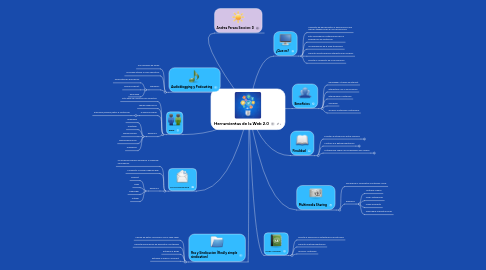
1. Social Bookmarking
1.1. los usuarios pueden almacenar y organizar informacion
1.2. Compartir y buscar paginas web
1.3. Ejemplos
1.3.1. Blinklist
1.3.2. Digg
1.3.3. Rawsugar
1.3.4. Sitebar
2. Wikis
2.1. Sitio web de construcción colectiva
2.2. Temas especificos
2.3. el usuario puede
2.3.1. adicionar,eliminar,editar el contenido
2.4. Ejemplos
2.4.1. Wikipedia
2.4.2. Wikitaller
2.4.3. Wikieconomia
2.4.4. Wikieneduacacion
2.4.5. Wikispace
3. Audioblogging y Podcasting
3.1. Son archivos de audio
3.2. Se puede utilizar a nivel educativo
3.3. Ejemplos
3.3.1. Podcasting en Educacion
3.3.2. Mundo Podcast
3.3.3. Educause
4. Rss y Sindicacion (Really simple sindication)
4.1. Familia de datos conocidos como "web feed"
4.2. permite informacion de diferentes contenidos
4.3. entradas a Blogs
4.4. entradas a audios y Podcast
5. Andrea Peraza Seccion: D
6. Blogs o Blogger
6.1. Facilita la publicacion instantaneas de entradas
6.2. Permite la retroalimentacion
6.3. Archivar contenido
7. ¿Que es?
7.1. Conjunto de herramientas y aplicaciones que Marcan tendencia en el uso de servicios
7.2. Esta formada por plataformas para la publicación de contenido
7.3. Se diferencian de la Web tradicional
7.4. Permite la participación interactiva de usuarios
7.5. Facilita el compartir de la informacion
8. Finalidad
8.1. Facilitar la interacción entre usuarios
8.1.1. Situational Analysis / Drivers
8.1.1.1. What is driving us to do this?
8.1.1.2. SWOT Analysis
8.1.1.2.1. Strengths
8.1.1.2.2. Weaknesses
8.1.1.2.3. Opportunities
8.1.1.2.4. Threats
8.1.1.3. Customer Findings - What have we learned from customers?
8.1.2. Competitive Analysis
8.1.2.1. Do we have competitors and threats in these target markets with the proposed offerings?
8.1.2.2. What are our competitors doing and how are they positioning?
8.1.2.3. How do we position against each competitor?
8.1.3. Target Customer(s)
8.1.3.1. Buyer Profile
8.1.3.1.1. Title
8.1.3.1.2. Industry
8.1.3.1.3. Geography
8.1.3.1.4. Business Size
8.1.3.2. Influencer Profile
8.1.3.3. User Profile
8.1.3.4. What do customers want and need?
8.1.3.5. What business problems do each of these customers have?
8.1.4. Customer Segmentation
8.1.4.1. Which customers or sets of customers do we sell to?
8.1.4.2. What are the target market segments that we want to go after?
8.1.4.3. What are the distinct problems for each segment of the market?
8.1.5. Total Available Market
8.1.5.1. New Prospects
8.1.5.1.1. How much of each target segment have we penetrated?
8.1.5.1.2. How much opportunity is available in each target segment?
8.1.5.2. Existing Customers
8.1.5.2.1. Can we up-sell existing customers?
8.2. Contruir a la Retroalimentacion
8.2.1. Service Offer
8.2.1.1. What are we selling?
8.2.1.2. Product Definition
8.2.1.3. Pricing
8.2.1.4. Packaging
8.2.1.5. Positioning
8.2.2. Value Proposition
8.2.2.1. What is the Value Proposition to the Customer?
8.2.2.2. What pain are we solving?
8.3. Actualizarse segun las necesidades del usuario
8.3.1. Revenue Forecasts
8.3.1.1. Revenue and P&L Forecast (5 Years)
8.3.1.2. Revenue should be split out quarterly
8.3.2. Cost Analysis
8.3.2.1. Should include a description of the costs in entering this business and profitability analysis
8.3.3. Profitability Analysis
8.3.3.1. P&L for the offer to include gross margin, net income and break even analysis.
9. Beneficios
9.1. Navegadar a través de internet
9.2. Interactuar con la informacion
9.3. Intercambiar Contenido
9.4. Socializar
9.5. Archivar materiales multimedias
10. Multimedia Sharing
10.1. Almacenan y comparten contenido Visual
10.2. Ejemplos
10.2.1. Youtube-Videos
10.2.2. Flickr-Fotografias
10.2.3. Odeo-Podcasts
10.2.4. SlideShare-Presentaciones
